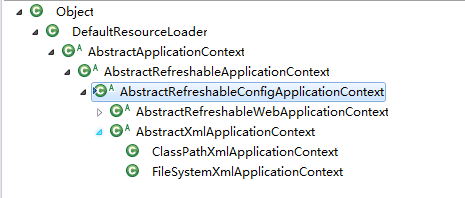spring bean 加载过程(spring)
以classpathXmlApplication为例
入口方法包含3个部分,
public ClassPathXmlApplicationContext(String[] configLocations, boolean refresh, ApplicationContext parent) throws BeansException { super(parent); setConfigLocations(configLocations); if (refresh) { refresh(); } }
1.继承父类,没什么东西
2.设置配置文件
3.执行refresh方法(关键)。下面我们就这两个方法看看内部实现
设置配置文件,这块其实没什么东西,就是给context对象设置一个configLocations的数组,我们看一下context类的继承关系

下面看重点的refresh方法
1 public void refresh() throws BeansException, IllegalStateException { 2 synchronized (this.startupShutdownMonitor) {//锁住一个对象,防止多线程同时执行初始化的操作 3 // Prepare this context for refreshing.准备上下文,这里设置一下开始实现,准备propery等 4 prepareRefresh(); 5 6 // Tell the subclass to refresh the internal bean factory. 7 ConfigurableListableBeanFactory beanFactory = obtainFreshBeanFactory(); 8 9 // Prepare the bean factory for use in this context. 10 prepareBeanFactory(beanFactory); 11 12 try { 13 // Allows post-processing of the bean factory in context subclasses. 14 postProcessBeanFactory(beanFactory); 15 16 // Invoke factory processors registered as beans in the context. 17 invokeBeanFactoryPostProcessors(beanFactory); 18 19 // Register bean processors that intercept bean creation. 20 registerBeanPostProcessors(beanFactory); 21 22 // Initialize message source for this context. 23 initMessageSource(); 24 25 // Initialize event multicaster for this context. 26 initApplicationEventMulticaster(); 27 28 // Initialize other special beans in specific context subclasses. 29 onRefresh(); 30 31 // Check for listener beans and register them. 32 registerListeners(); 33 34 // Instantiate all remaining (non-lazy-init) singletons. 35 finishBeanFactoryInitialization(beanFactory); 36 37 // Last step: publish corresponding event. 38 finishRefresh(); 39 } 40 41 catch (BeansException ex) { 42 if (logger.isWarnEnabled()) { 43 logger.warn("Exception encountered during context initialization - " + 44 "cancelling refresh attempt: " + ex); 45 } 46 47 // Destroy already created singletons to avoid dangling resources. 48 destroyBeans(); 49 50 // Reset 'active' flag. 51 cancelRefresh(ex); 52 53 // Propagate exception to caller. 54 throw ex; 55 } 56 57 finally { 58 // Reset common introspection caches in Spring's core, since we 59 // might not ever need metadata for singleton beans anymore... 60 resetCommonCaches(); 61 } 62 } 63 }
这个代码有点长,我们把每个方法干什么先研究一下,在深入看每个方法怎么实现的。
从7行开始看,这个方法是为了一个refreshBeanFactory。返回的类是ConfigurableListableBeanFactory,而这个factory是一个接口,我们待会看看这个接口有哪些实现,先看看这个方法内部实现
protected ConfigurableListableBeanFactory obtainFreshBeanFactory() { refreshBeanFactory(); ConfigurableListableBeanFactory beanFactory = getBeanFactory(); if (logger.isDebugEnabled()) { logger.debug("Bean factory for " + getDisplayName() + ": " + beanFactory); } return beanFactory; }
我们看到最后return的beanFactory就是ConfigurableListableBeanFactory。而这个接口只有一个default实现类DefaultListableBeanFactory。我们看看这个类主要有哪些成员变量
1 private boolean allowEagerClassLoading = true; 2 3 /** Optional OrderComparator for dependency Lists and arrays */ 4 private Comparator<Object> dependencyComparator; 5 6 /** Resolver to use for checking if a bean definition is an autowire candidate */ 7 private AutowireCandidateResolver autowireCandidateResolver = new SimpleAutowireCandidateResolver(); 8 9 /** Map from dependency type to corresponding autowired value */ 10 private final Map<Class<?>, Object> resolvableDependencies = new ConcurrentHashMap<Class<?>, Object>(16); 11 12 /** Map of bean definition objects, keyed by bean name */ 13 private final Map<String, BeanDefinition> beanDefinitionMap = new ConcurrentHashMap<String, BeanDefinition>(256); 14 15 /** Map of singleton and non-singleton bean names, keyed by dependency type */ 16 private final Map<Class<?>, String[]> allBeanNamesByType = new ConcurrentHashMap<Class<?>, String[]>(64); 17 18 /** Map of singleton-only bean names, keyed by dependency type */ 19 private final Map<Class<?>, String[]> singletonBeanNamesByType = new ConcurrentHashMap<Class<?>, String[]>(64); 20 21 /** List of bean definition names, in registration order */ 22 private volatile List<String> beanDefinitionNames = new ArrayList<String>(256); 23 24 /** List of names of manually registered singletons, in registration order */ 25 private volatile Set<String> manualSingletonNames = new LinkedHashSet<String>(16); 26 27 /** Cached array of bean definition names in case of frozen configuration */ 28 private volatile String[] frozenBeanDefinitionNames; 29 30 /** Whether bean definition metadata may be cached for all beans */ 31 private volatile boolean configurationFrozen = false;
这些成员变量有机会我们一个个分析下,我们知道每个bean 有一个beanDefinition对象来定义。在13行,我们看到有一个BeanDefinition的Map,我们随便调试一下,看看这个里面存了什么东西。

这里面竟然只有7个对象,分别是:ConfigurationClassPostProcessor、DefaultEventListenerFactory、MessageResolver、EventListenerMethodProcessor、AutowiredAnnotationBeanPostProcessor、CommonAnnotationBeanPostProcessor、PropertiesFactoryBean、RequiredAnnotationBeanPostProcessor。这七个对象怎么来的呢,举个例子来看ConfigurationClassPostProcessor,这个类说明是,当配置文件中
Registered by default when using {@code <context:annotation-config/>} or
* {@code <context:component-scan/>}有这两个配置的时候,便会注入这么个类。好吧,那我们看看在哪里register的。我们猜测是在
refreshBeanFactory();这个方法里面。那看看这个方法
1 protected final void refreshBeanFactory() throws BeansException { 2 if (hasBeanFactory()) { 3 destroyBeans(); 4 closeBeanFactory(); 5 } 6 try { 7 DefaultListableBeanFactory beanFactory = createBeanFactory(); 8 beanFactory.setSerializationId(getId()); 9 customizeBeanFactory(beanFactory); 10 loadBeanDefinitions(beanFactory); 11 synchronized (this.beanFactoryMonitor) { 12 this.beanFactory = beanFactory; 13 } 14 } 15 catch (IOException ex) { 16 throw new ApplicationContextException("I/O error parsing bean definition source for " + getDisplayName(), ex); 17 } 18 }
我们看到第7行,创建了一个DefaultListableBeanFactory ,第10行有loadBeanDefinition。应该是在这里处理的。我们还是先调试下看看。执行7行代码,这个时候beanDefinitionMap是空的。执行完10行代码,我们的beanDefinitionMap有值了。这里面为了加深理解,我们在我们的spring-config.xml文件中加一个bean看看会怎么样。原来的spring-config.xml文件如下
1 <?xml version="1.0" encoding="UTF-8"?> 2 <beans xmlns="http://www.springframework.org/schema/beans" 3 xmlns:xsi="http://www.w3.org/2001/XMLSchema-instance" 4 xmlns:context="http://www.springframework.org/schema/context" 5 xmlns:util="http://www.springframework.org/schema/util" 6 xsi:schemaLocation=" 7 http://www.springframework.org/schema/beans 8 http://www.springframework.org/schema/beans/spring-beans-4.1.xsd 9 http://www.springframework.org/schema/context 10 http://www.springframework.org/schema/context/spring-context-4.1.xsd 11 http://www.springframework.org/schema/util 12 http://www.springframework.org/schema/util/spring-util-4.1.xsd"> 13 14 <context:annotation-config/> 15 16 <context:component-scan base-package="com.newbie.common"></context:component-scan> 17 18 <util:properties id="systemProperties" location="classpath:conf/user.properties" /> 19 20 21 </beans>
我们随便加一个bean,如下图所示,有多个一个beanDefinition。所以这个地就是定义所以beanDefinition的入口,而我们从autowire的bean是由相关processor处理的,这个今后如果有时间的话,我们在分析。我们继续往下看

我们回到原来的refresh方法里面。
1 public void refresh() throws BeansException, IllegalStateException { 2 synchronized (this.startupShutdownMonitor) { 3 // Prepare this context for refreshing. 4 prepareRefresh(); 5 6 // Tell the subclass to refresh the internal bean factory. 7 ConfigurableListableBeanFactory beanFactory = obtainFreshBeanFactory(); 8 9 // Prepare the bean factory for use in this context. 10 prepareBeanFactory(beanFactory); 11 12 try { 13 // Allows post-processing of the bean factory in context subclasses. 14 postProcessBeanFactory(beanFactory); 15 16 // Invoke factory processors registered as beans in the context. 17 invokeBeanFactoryPostProcessors(beanFactory); 18 19 // Register bean processors that intercept bean creation. 20 registerBeanPostProcessors(beanFactory); 21 22 // Initialize message source for this context. 23 initMessageSource(); 24 25 // Initialize event multicaster for this context. 26 initApplicationEventMulticaster(); 27 28 // Initialize other special beans in specific context subclasses. 29 onRefresh(); 30 31 // Check for listener beans and register them. 32 registerListeners(); 33 34 // Instantiate all remaining (non-lazy-init) singletons. 35 finishBeanFactoryInitialization(beanFactory); 36 37 // Last step: publish corresponding event. 38 finishRefresh(); 39 } 40 41 catch (BeansException ex) { 42 if (logger.isWarnEnabled()) { 43 logger.warn("Exception encountered during context initialization - " + 44 "cancelling refresh attempt: " + ex); 45 } 46 47 // Destroy already created singletons to avoid dangling resources. 48 destroyBeans(); 49 50 // Reset 'active' flag. 51 cancelRefresh(ex); 52 53 // Propagate exception to caller. 54 throw ex; 55 } 56 57 finally { 58 // Reset common introspection caches in Spring's core, since we 59 // might not ever need metadata for singleton beans anymore... 60 resetCommonCaches(); 61 } 62 } 63 }
我们现在知道第7行返回的这个ConfigurableListableBeanFactory 有我们所有的beanDefintion。这个方法是给ConfigurableListableBeanFactory 设置了若干预设变量,现在我们也不清楚这个变量是干嘛的,我们先跳过这个方法,等回头再分析他。
第14行postProcessBeanFactory(ConfigurableListableBeanFactory )。我们看看这个代码是做什么事情,我们有一个关注点,我们@autowired的bean是怎么被处理的。这个代码,会根据不同context子类加入不同Processors,这个我们也暂时不分析他,等回头再看
第17行invokeBeanFactoryPostProcessors(ConfigurableListableBeanFactory )。这个方法应该就是能看到bean是如何创建的。这个代码比较长,我们先把调用关系简单画出来

执行invokeBeanFactoryPostProcessors之后,这里主要是讲各个processors类注册进去,这里需要获得具体的bean了,根据beanName和BeanDefinition。如何获得bean,通过DefaultListableBeanFactory的getBean方法,这里判断bean是单利还是原型的,进入不同的getBean的逻辑,之后调用的AbstractAutowireCapableBeanFactory的createBean方法,之后通过反射来获得对应的bean。注意看一下doCreateBean方法里面的populateBean()方法,这里能够完成对属性的注入。
上面这个方法,我们调用的时候发现就注册了一个ConfigurationClassPostProcessor,也不知道干嘛的。后来通过搜索了解到这个方法主要是用于处理spring的后置处理器的相关内容,参考https://www.cnblogs.com/sishang/p/6588542.html和https://www.cnblogs.com/sishang/p/6576665.html。


